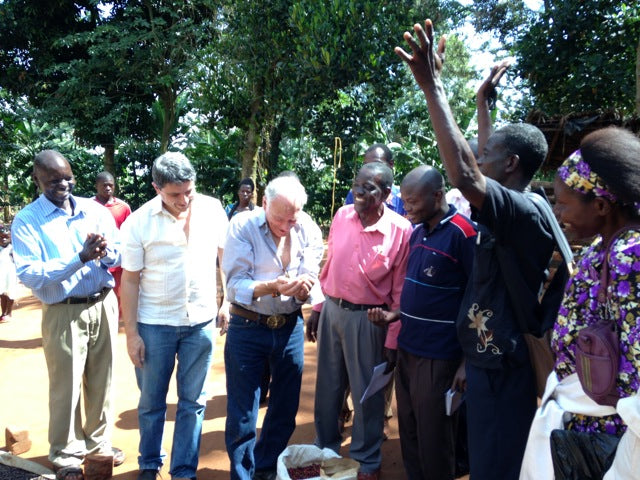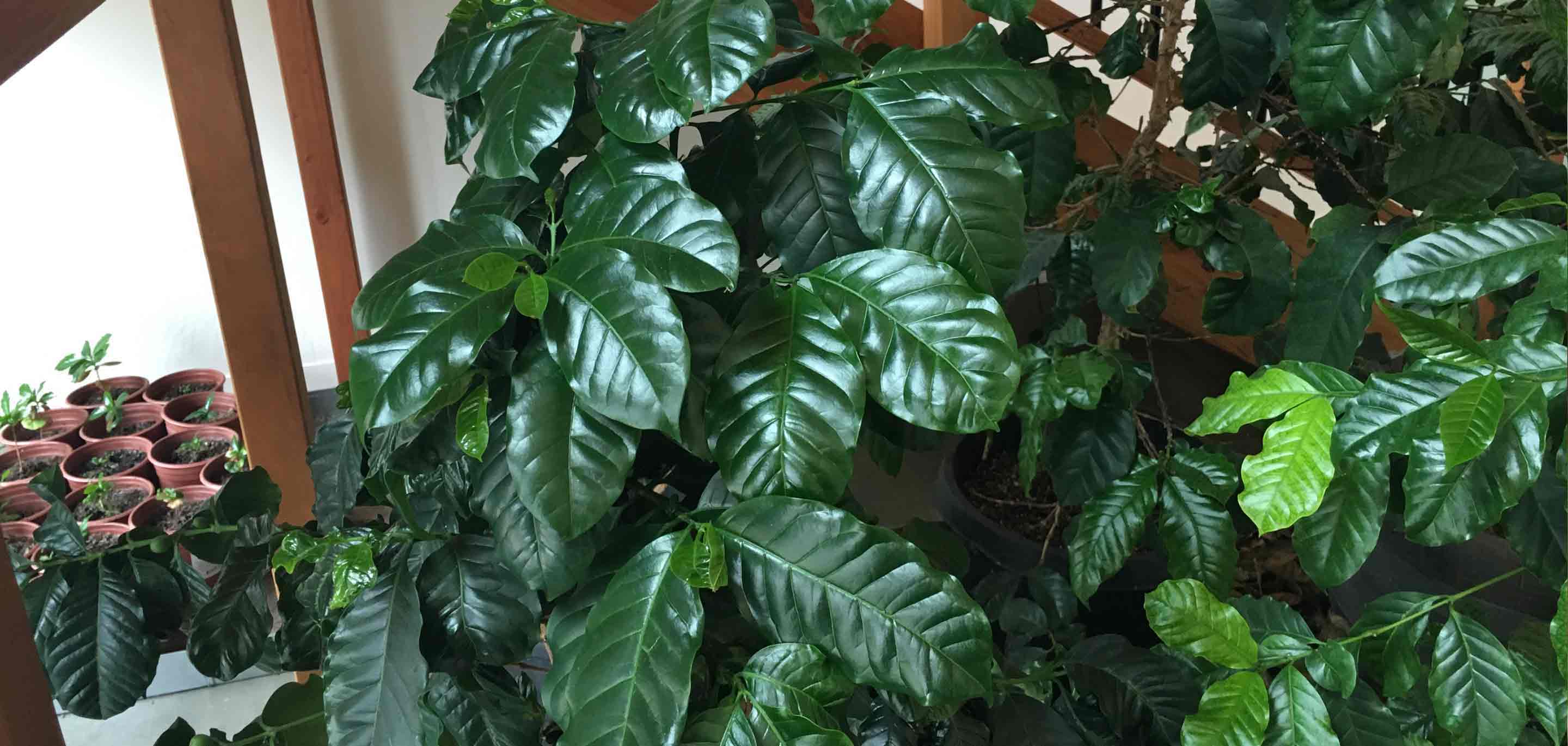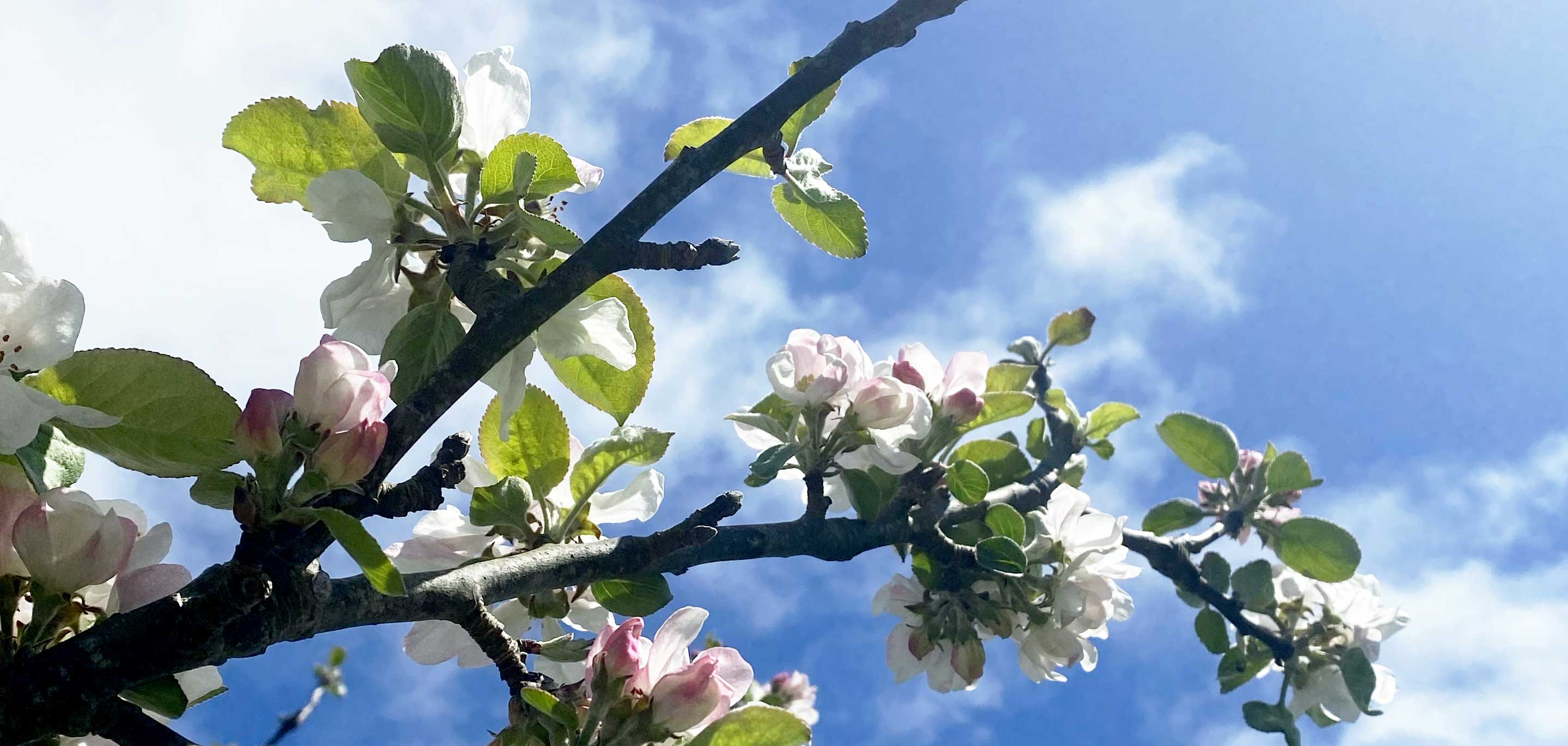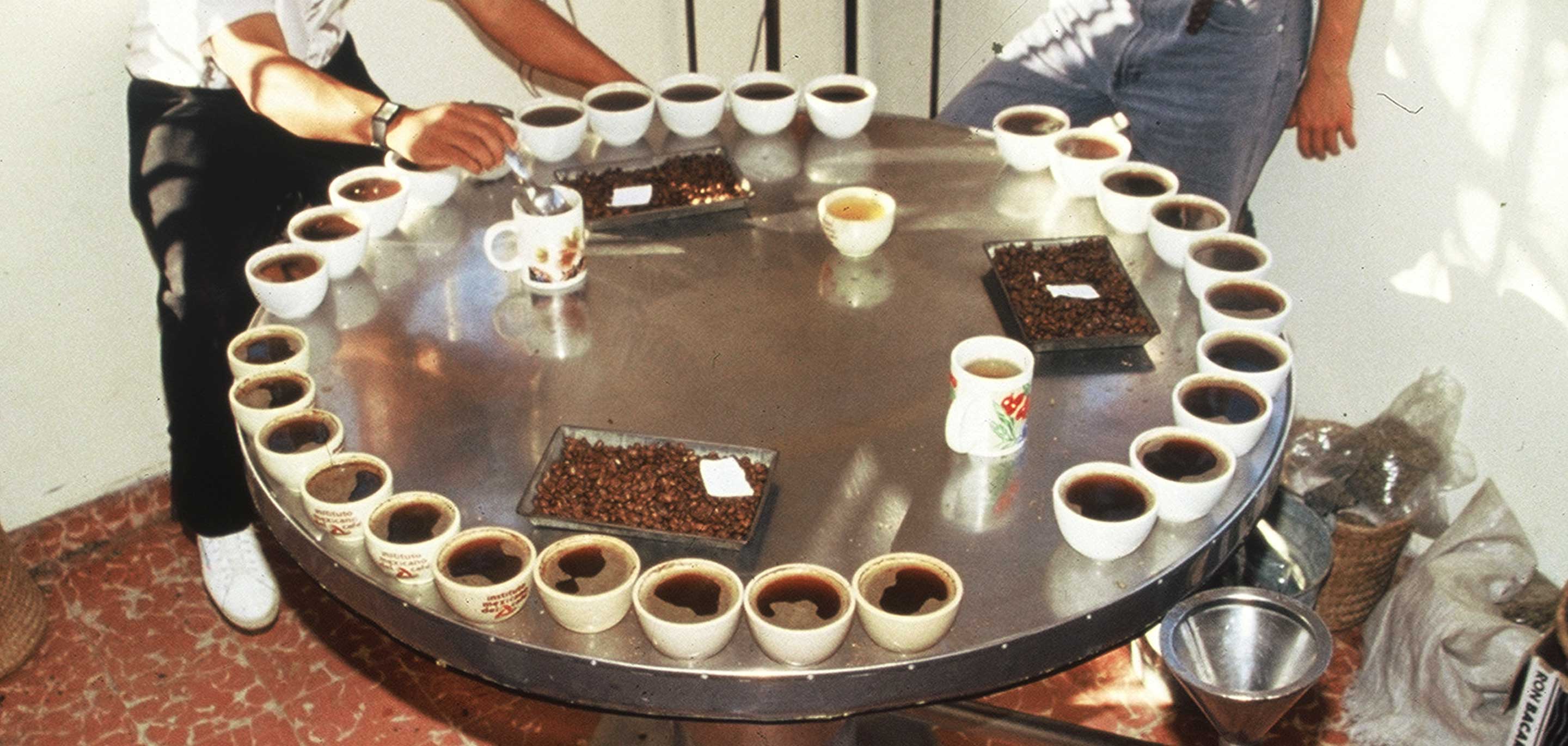
Our Blog
A Trip to Africa: Day 1 - Arriving In Uganda
View BY :
A Trip to Africa: Day 1 - Arriving In Uganda
In January 2014, CEO & Co-Founder Paul Katzeff traveled to Africa to meet with two of our producer cooperatives. In this blog series, Paul shares his experience in Uganda and Rwanda.
We arrived in Uganda (Entebbe Airport) at midnight. In two hours we were in Jinja to visit a coffee cooperative that is producing organic Robusta coffee. This might be the only organic Robusta in the world - so I was eager to meet the farmers. Our hosts and drivers were from Communities of Shalom, a US-based interfaith social justice organization based at Drew University that has been doing Economic Development work at the cooperative for the past nine months. They work to build community strength and empower coffee farmers to run their cooperatives effectively - so that they can benefit farmers and their families. We awoke the following morning to see Lake Victoria from our hotel window. Lake Victoria is the headwaters to the Nile. I felt the water, just as I did the Mississippi River 50 years ago when I first crossed it. It felt good!

Chairperson Fredrick Kibalama and CEO of Thanksgiving Coffee , Paul Katzeff
On the Coop chairman's farm we posed for a picture. Note the large Mango tree in the background and the Banana tree under it to the left. The weather was mild, about 80 degrees, and the sun was beginning to warm the top of my head. Fredrick's farm was about as self-sufficient food wise as one would enjoy here in the USA.

Here you can see the coffee trees being shaded by the Banana trees and the large trunk in the background of a very tall Mango tree shading all the undergrowth, keeping the ground cool and the moisture in this soil. I loved the Sign that reads "Organic Power Plant," a broad-based double-meaning set of words. One cow's manure will fertilize 1,000 coffee trees per year and the urine tea provides nitrogen. No waste here. Plus, milk and cheese for the family. Organic Power Plant indeed!

Robusta coffee is processed using what is called "The Dry Method." The cherries put out in the sun to dry. Fredrick had some recent pickings drying on a plastic mat when we arrived and about another 25 pounds of ripe cherries ready for sun drying with the cherry pulp still on the cherry. You can see how they turn black when they dry. In this photo I am smelling the de-hulled and finished coffee that was taken from the paper bag next to the sack of cherries. The beans were clean and sweet smelling and foretold, I hope, a bright future in the cup.

When I congratulated the farmers on a job well done, Moses (the Community's political leader) and the farmers were happy campers. This is because last year, the sample brought back to me was dirty and moldy, so I rejected it and sent instructions for them to follow for the next harvest season. This time, I was there to buy their coffee if it was clean and smelled sweet. Robusta is not a coffee variety that is noted for its flavor but it is useful in many other ways (body in Espresso blends for one). I agreed to purchase the coffee and I became the coop's first international buyer.

In this photo, my associate and Board member of Thanksgiving Coffee who is an expert on coffee supply chain infrastructure (how to get it from there to here), was explaining something we found by pure luck. It was, as I explained to the farmers, perfect timing that we arrived to see a potential disaster averted. Nick was showing them the problem. On the mat in front of him, the black drying cherries had a white mold softly covering the skins. The cherries were allowed to dry too slowly. They were probably not covered at night and the dew promoted the mold growth.
But, as luck would have it, there was a fresher lot to the right on the same mat and it was mold free. The lessons were there to be drilled home. All it took was a smell test and everyone knew what was needed, especially when I told them that the moldy smell was just a smell, but could they imagine drinking a coffee that tasted moldy ? The batch was separated and the potential for the coop coffees improved...if word gets out to all the farmers in the Coop.
To be continued
-Paul
A Trip to Africa (series archive)
Day 2 – Dancing, Mango Trees & the Dry Mill
Day 4 – Transparency, Trust & Relationships
Day 5 - Coffee Quality & A New Mystery
Day 6 – The Mystery Coffee’s Story
Recommended Reading
Back to the Blog-
![How To Grow Coffee Trees]()
The Roots of Your Morning Brew: Understanding the Coffee Plant
For many, coffee is the ritualistic start to the day, a beloved beverage that energizes and comforts. Yet, beyond the steaming cups and aromatic brews lies the coffee plant, a botanical wonder that is the genesis of every coffee lover’s journey. At the heart of Thanksgiving Coffee Company is a deep appreciation for this living tree source—the company respects and values the entire process, from the nurturing soil that cradles the seed to the satisfying sip that completes the circle. We have been connecting to this plant by growing our own coffee trees right here for many years.
Coffee Trees Growing at the Thanksgiving Coffee Company Office
Anatomy of the Coffee Plant: More Than Just Beans
The coffee plant, with its glossy green leaves and ripe cherries, is both an aesthetic marvel and a complex organism. Beneath the soil, its roots anchor the plant and absorb vital nutrients. Above ground, the leaves play a crucial role in photosynthesis, while the bright red cherries house the precious beans inside. It's these beans that, once processed and roasted, give rise to the alluring aromas and rich flavors that characterize each cup of coffee.
Varied Flavors: The Many Varieties of Coffee Plants
Ripe coffee cherries on the Arabica coffee tree grown at the office
When you think of coffee, the two dominant species: Arabica and Robusta, likely come to mind. Arabica is prized for its smoother, more nuanced taste, while Robusta is revered for its robustness and higher caffeine content. However, there exists a myriad of lesser-known varieties, each with its own unique flavor profile, waiting to be discovered by eager coffee connoisseurs.
From the Soil to your first Sip: How Terroir Affects Your Coffee
Like fine wine, coffee is influenced by its terroir—the environment in which it's grown. The climate, soil composition, and even the angle of sunlight on the slopes where coffee plants thrive collectively contribute to the coffee's flavor profile. These factors, often subtle and complex, define a coffee's body, acidity, and notes, creating an array of tastes as diverse as the landscapes from which they come.
Ripe cherries harvested from our coffee trees.
Ready to Discover the Flavor of Your Own Coffee
If you are inspired to develop a closer relationship with your coffee and want to lean into the root system of your daily coffee ritual, we have a series for you. Our co-founder Paul Katzeff has been growing coffee trees at home for years, and will lead you through his process.
Check out the series:
Part I: The Beauty of Growing Coffee Trees in Your Home
Part II: All you Need to Know About Growing Coffee Trees At Home
Part III: Caring For Your Coffee Tree
Coffee Tree Source:
Lavender Grace is the Sustainability Consultant for Thanksgiving Coffee Company.
Growing Coffee At HomeHow To Grow Coffee Trees
read more -
![Brewing Possibility: Our 2024 Impact Report]()
Our 2024 Impact Report
At Thanksgiving Coffee, every roast begins with a question: What really matters?
In 2024, we found answers by listening—to farmers, to customers, to our team, and to the land. The result is the most honest and grounded Impact Report (pdf) yet: a reflection of where we’ve been and where we’re headed next.
As we simplify our product line to focus on what we do best, we’re holding tight to the relationships and regenerative values that have always defined our work. That means sourcing from smallholder cooperatives, supporting ecological resilience, and roasting every bean with care and intention.
“Coffee, when done right, Is A Relationship.”
In 2024, we listened more deeply than ever:
⭐ 88.9% of our green coffee was Certified Organic
⭐ $91,529 donated to causes we care about
⭐ Verified health and income gains from clean energy investments in Uganda
⭐ Roasting with purpose for 52 years and countingOur Ongoing Commitments
We remain committed to being ethically sourced and artisan roasted, maintaining over 88% of our coffees certified Organic, and guiding all purchases by our Purchasing for a Healthier Planet criteria. (This criteria was established in 1995 and is still going strong.)
While we're retiring many of our Cause Coffees this year, a few important ones will remain and their impact continues. From restoring pollinator habitat to protecting migratory bird forests, your daily cup still fuels change where it’s needed most.
Biodiversity loss is one of the most urgent challenges of our time, and we’re proud to stand with the growers, ecologists, and educators who are working to reverse it—one forest, one garden, one farm at a time.
Past Impact Reports
Lavender Grace is the Sustainability Consultant for Thanksgiving Coffee Company
2024 Impact ReportBrewing Possibility: Our 2024 Impact Report
read more -
![Rwanda Resilience: Coffee with a Climate Impact]()
Taste the Bright Future of Coffee
Our Rwanda Single Origin offers more than just incredible flavor—it’s a coffee that supports community resilience. Grown at high elevations in Musasa, Rwanda, by the Dukunde Kawa Cooperative, this medium roast delivers:- Tasting Notes: Vibrant citrus, delicate florals, and a smooth honey finish
- Mouthfeel: Silky and refreshing, with a bright, clean finish
- Perfect for: Pour over, drip, or French press—ideal for your morning clarity ritual
Rwanda Single Origin Coffee with citrus, floral, and honey tasting notes from Dukunde Kawa.
Why Dukunde Kawa Coffee Matters
Dukunde Kawa means “Let’s love coffee”—a name that reflects their commitment to people, planet, and flavor. This Rwandan cooperative is internationally recognized for combining exceptional quality with climate action.
Climate Resilience in Action:
- 2,500+ Clean Cook stoves Installed, reducing wood use by 70%
- Tree Nurseries Restoring Biodiversity, combating soil erosion
- Women’s Leadership, with 80% women participation at the Ruli washing station
Rwanda coffee farm
Sources:Dukunde Kawa Sustainability Programs
Thanksgiving Coffee Dukunde Kawa Story
Every bag of Rwanda Single Origin supports these impactful programs, making every cup an act of regeneration and reciprocity.
Brew a Better Morning, Support a Better Future
Every time you brew Rwanda Single Origin, you:- Support Healthier Homes with clean cook stove initiatives
- Restore Forests and Farms through reforestation efforts
- Empower Women Farmers, nurturing local leadership
Brewing Highlight: Cold Brew for Summer Brightness
Recipe Idea:
Show off the bright notes of Rwanda Single Origin with this easy cold brew:- Coarse grind 1 cup of beans
- Steep in 4 cups of filtered water for 12-14 hours
- Serve over ice with a twist of fresh orange peel
Refreshing, vibrant, and perfect for a summer coffee ritual.Explore More Flavor Stories
Lavender Grace is the Sustainable Ecology Advocate for Thanksgiving Coffee Company
Artisan RoastedRwanda Resilience: Coffee with a Climate Impact
read more

The Roots of Your Morning Brew: Understanding the Coffee Plant
For many, coffee is the ritualistic start to the day, a beloved beverage that energizes and comforts. Yet, beyond the steaming cups and aromatic brews lies the coffee plant, a botanical wonder that is the genesis of every coffee lover’s journey. At the heart of Thanksgiving Coffee Company is a deep appreciation for this living tree source—the company respects and values the entire process, from the nurturing soil that cradles the seed to the satisfying sip that completes the circle. We have been connecting to this plant by growing our own coffee trees right here for many years.
Coffee Trees Growing at the Thanksgiving Coffee Company Office
Anatomy of the Coffee Plant: More Than Just Beans
The coffee plant, with its glossy green leaves and ripe cherries, is both an aesthetic marvel and a complex organism. Beneath the soil, its roots anchor the plant and absorb vital nutrients. Above ground, the leaves play a crucial role in photosynthesis, while the bright red cherries house the precious beans inside. It's these beans that, once processed and roasted, give rise to the alluring aromas and rich flavors that characterize each cup of coffee.
Varied Flavors: The Many Varieties of Coffee Plants
Ripe coffee cherries on the Arabica coffee tree grown at the office
When you think of coffee, the two dominant species: Arabica and Robusta, likely come to mind. Arabica is prized for its smoother, more nuanced taste, while Robusta is revered for its robustness and higher caffeine content. However, there exists a myriad of lesser-known varieties, each with its own unique flavor profile, waiting to be discovered by eager coffee connoisseurs.
From the Soil to your first Sip: How Terroir Affects Your Coffee
Like fine wine, coffee is influenced by its terroir—the environment in which it's grown. The climate, soil composition, and even the angle of sunlight on the slopes where coffee plants thrive collectively contribute to the coffee's flavor profile. These factors, often subtle and complex, define a coffee's body, acidity, and notes, creating an array of tastes as diverse as the landscapes from which they come.
Ripe cherries harvested from our coffee trees.
Ready to Discover the Flavor of Your Own Coffee
If you are inspired to develop a closer relationship with your coffee and want to lean into the root system of your daily coffee ritual, we have a series for you. Our co-founder Paul Katzeff has been growing coffee trees at home for years, and will lead you through his process.
Check out the series:
Part I: The Beauty of Growing Coffee Trees in Your Home
Part II: All you Need to Know About Growing Coffee Trees At Home
Part III: Caring For Your Coffee Tree
Coffee Tree Source:
Lavender Grace is the Sustainability Consultant for Thanksgiving Coffee Company.
How To Grow Coffee Trees
read more
Our 2024 Impact Report
At Thanksgiving Coffee, every roast begins with a question: What really matters?
In 2024, we found answers by listening—to farmers, to customers, to our team, and to the land. The result is the most honest and grounded Impact Report (pdf) yet: a reflection of where we’ve been and where we’re headed next.
As we simplify our product line to focus on what we do best, we’re holding tight to the relationships and regenerative values that have always defined our work. That means sourcing from smallholder cooperatives, supporting ecological resilience, and roasting every bean with care and intention.
“Coffee, when done right, Is A Relationship.”
In 2024, we listened more deeply than ever:
⭐ 88.9% of our green coffee was Certified Organic
⭐ $91,529 donated to causes we care about
⭐ Verified health and income gains from clean energy investments in Uganda
⭐ Roasting with purpose for 52 years and counting
Our Ongoing Commitments
We remain committed to being ethically sourced and artisan roasted, maintaining over 88% of our coffees certified Organic, and guiding all purchases by our Purchasing for a Healthier Planet criteria. (This criteria was established in 1995 and is still going strong.)
While we're retiring many of our Cause Coffees this year, a few important ones will remain and their impact continues. From restoring pollinator habitat to protecting migratory bird forests, your daily cup still fuels change where it’s needed most.
Biodiversity loss is one of the most urgent challenges of our time, and we’re proud to stand with the growers, ecologists, and educators who are working to reverse it—one forest, one garden, one farm at a time.
Past Impact Reports
Lavender Grace is the Sustainability Consultant for Thanksgiving Coffee Company
Brewing Possibility: Our 2024 Impact Report
read more
Taste the Bright Future of Coffee
- Tasting Notes: Vibrant citrus, delicate florals, and a smooth honey finish
- Mouthfeel: Silky and refreshing, with a bright, clean finish
- Perfect for: Pour over, drip, or French press—ideal for your morning clarity ritual
Rwanda Single Origin Coffee with citrus, floral, and honey tasting notes from Dukunde Kawa.
Why Dukunde Kawa Coffee Matters
Dukunde Kawa means “Let’s love coffee”—a name that reflects their commitment to people, planet, and flavor. This Rwandan cooperative is internationally recognized for combining exceptional quality with climate action.
Climate Resilience in Action:
- 2,500+ Clean Cook stoves Installed, reducing wood use by 70%
- Tree Nurseries Restoring Biodiversity, combating soil erosion
- Women’s Leadership, with 80% women participation at the Ruli washing station
Rwanda coffee farm
Dukunde Kawa Sustainability Programs
Thanksgiving Coffee Dukunde Kawa Story
Every bag of Rwanda Single Origin supports these impactful programs, making every cup an act of regeneration and reciprocity.
Brew a Better Morning, Support a Better Future
- Support Healthier Homes with clean cook stove initiatives
- Restore Forests and Farms through reforestation efforts
- Empower Women Farmers, nurturing local leadership
Brewing Highlight: Cold Brew for Summer Brightness
Show off the bright notes of Rwanda Single Origin with this easy cold brew:
- Coarse grind 1 cup of beans
- Steep in 4 cups of filtered water for 12-14 hours
- Serve over ice with a twist of fresh orange peel
Lavender Grace is the Sustainable Ecology Advocate for Thanksgiving Coffee Company
Rwanda Resilience: Coffee with a Climate Impact
read more
The Cupping Lab Revolution: How Thanksgiving Coffee Changed Coffee Forever
Cupping Coffee , Nicaragua
It began with a journey to Nicaragua in the 1980s. Paul Katzeff, a former social worker and co-founder of Thanksgiving Coffee, traveled to listen to the farmers. Paul had the tools and vision to create a new way forward for the coffee world.
In those war-torn hills, Paul came face to face with the quiet strength of farmers who had survived conflict, drought, and poverty. What he discovered would transform his understanding of coffee forever.
What Paul saw was that coffee could be more than just a product. It could become a tool for restoring dignity, building solidarity, and giving voice to those who had been left out of their own story.
Nicaruaguan Coffee Farmers coming home, photo by Paul Katzeff
Coffee as a Bridge Between Worlds
Paul's 1985 trip to Nicaragua occurred during the U.S.-backed Contra War—a time of immense hardship and tension. What he witnessed moved him deeply: farmers cultivating resilience amid unimaginable challenges. Meeting with PRODECOOP, one of the earliest farmer cooperatives, he understood that meaningful change would require more than charity. It would take genuine partnership.
This experience birthed a vision for direct trade built on empathy and transparency. Paul saw coffee as more than a commodity—he saw it as a bridge connecting people across borders, across struggles, and across systems built to exclude the voices of those who grow the coffee we love.
Coffee Processing Nicaragua
Preparing coffee to dry - Nicaragua
Roasting coffee in traditional oven at the Lopado Farm, Nicaragua, photo by Paul Katzeff
Grinding coffee in traditional outdoor style, photo by Paul Katzeff
A Revolution Born from Relationship
Years later, in 2001, Paul's vision took physical form when Thanksgiving Coffee helped create the world's first farmer-owned cupping labs. It started with a simple question:
What if those who grow the coffee were also the ones to taste it first?
That question sparked a revolution—and in partnership with our co-ops like UCA MIRAFLOR and CECOCAFEN, it redefined not just how coffee is evaluated, but who gets to define its value.
This work began with trust.
When Thanksgiving Coffee first partnered with these cooperatives, they were communities rising from hardship with their own vision. Families were replanting forests, rebuilding homes, and forming cooperatives that prioritized not only trade, but democracy, biodiversity, and food sovereignty.
Frank Lanzas Family
Fernandito Family
Fernando Beneficio
Maria Elena
As field researcher Christopher Bacon wrote:
"This is a story of reconstruction and resistance... of families working together to regenerate their communities, reclaim the land, and build new institutions of democratic governance."
In these post-war communities, farmers didn't just return to the land—they reimagined its future. By placing cupping labs in their hands, Thanksgiving Coffee wasn't introducing a new tool—they were honoring a movement already in motion.
Redefining the Waves: How Cupping Labs Transformed Coffee Culture
The history of specialty coffee is often described in "waves." The First Wave brought coffee to the masses. The Second Wave introduced espresso culture and coffee as an experience.
But it was the Third Wave—focused on origin, transparency, and craft—that truly began to value the farmer's role. And it was here that Thanksgiving Coffee's cupping labs created their most profound impact.
The Coffee Cuppers Manifesto, by Paul Katzeff 2001
"The $300,000 enabled 9 coops to build their labs and be trained as cuppers by me using SCAA scoring forms. It is one thing to have a lab but another thing to know how to use it. Training was essential. "
- Paul Katzeff
In 1999, when most coffee buyers still made quality decisions without farmer input, Thanksgiving Coffee proposed something radical: building professional cupping labs directly within producer cooperatives in Nicaragua. With a $300,000 USAID contract and decades of field experience, these labs were constructed in 2000, becoming the world's first farmer-owned and operated cupping facilities.
The innovation couldn't have been better timed. As Third Wave coffee culture was gaining momentum in the early 2000s with its focus on single-origin beans and transparent sourcing, these cupping labs equipped farmers to meet this new demand with unprecedented precision.
Suddenly, farmers could:
- Taste and analyze their own coffee before it left the farm
- Create detailed flavor profiles previously only done by importers
- Develop specific micro-lots for specialty markets
- Experiment with processing methods that enhanced quality
- Engage in price negotiations based on verifiable quality data
By 2001, the Cuppers Manifesto was born—a bilingual manual distributed to 10,000 Nicaraguan farmers and later shared with 8,000 producers in Colombia by the Colombian Coffee Federation.
Coffee Processing Nicaragua, photo by Paul Katzeff
From Third Wave to Fourth: Farmers as Flavor Artists
What began as a Third Wave innovation has evolved into something even more profound—what many now call the "Fourth Wave" of coffee, where farmers themselves have become recognized artists of flavor creation.
Today's most celebrated coffees often feature not just the region or farm name, but specific processing techniques developed and perfected by individual farmers—techniques like honey processing, extended fermentation, and anaerobic processing that create distinctive flavor profiles impossible to achieve through roasting alone.
This transition—from farmers as anonymous producers to farmers as named innovators—can be traced directly back to those first cupping labs. When farmers gained the ability to taste, evaluate, and experiment with their own coffee, they unleashed a wave of innovation that continues to transform the industry.
As Paul shared in a later interview:
"Coffee is about people. If you take care of the people, the coffee takes care of itself."
These labs didn't just reflect a shift in coffee culture—they helped create it. From these humble beginnings in rural Nicaragua grew the foundations of today's artisan coffee movement, where quality and value begin at the source and rise through shared craftsmanship.
UCA Miraflor Cooperative, 2023 Nicaragua
Hermanez Montenegro Family with drying coffee behind, photo by Paul Katzeff
A Legacy You Can Taste
SongBird Nicaraguan, Medium Roast
From UCA MIRAFLOR, this coffee represents the pinnacle of farmer-led quality development.
Bird Friendly certified, it supports both sustainable farming and migratory bird habitat.
Tasting Notes: Mango, nutty, chocolate
Miel de Cajamarca, Light Roast
From CENFROCAFE, Peru. Named for the honey-processing techniques refined in origin cupping labs.
This coffee showcases the artisan experimentation that defines Fourth Wave coffee.
Tasting Notes: Honey, papaya, milk chocolate
Join the Revolution in Your Cup
The Cupping Lab Revolution was more than the technology of tasting coffee. It was—and still is—about relationship, repair, and reclaiming the right to define what coffee can be.
Every cup of Thanksgiving Coffee connects you to this ongoing story of transformation—from Third Wave transparency to Fourth Wave farmer artisanship. It's an invitation to participate in a more equitable, relationship-based trade model that honors both the product and its producers.
It is about following a path with heart to let it guide you to be in good relationship with life and the world.
The Cupping Legacy continues - on the left, CEO Jonah Katzeff - on the right, Co-Founder and Board President Paul Katzeff of Thanksgiving Coffee Company
The Way
"The way to great coffee flavor is not direct.
The path must be traveled
with great care and attention.
The way becomes a path, the path a road,
and then, magically, the road becomes a highway
that leads to people who cultivate the land on which the coffee derives its special flavor.
How does one find the path? Through caring.
One does not search so much for the road that leads to the tree, as for the road that leads to the heart.
This is the secret."
Paul Katzeff
Co-founder, Thanksgiving Coffee Company
Lavender Grace is the Sustainability Consultant for Thanksgiving Coffee Company.


